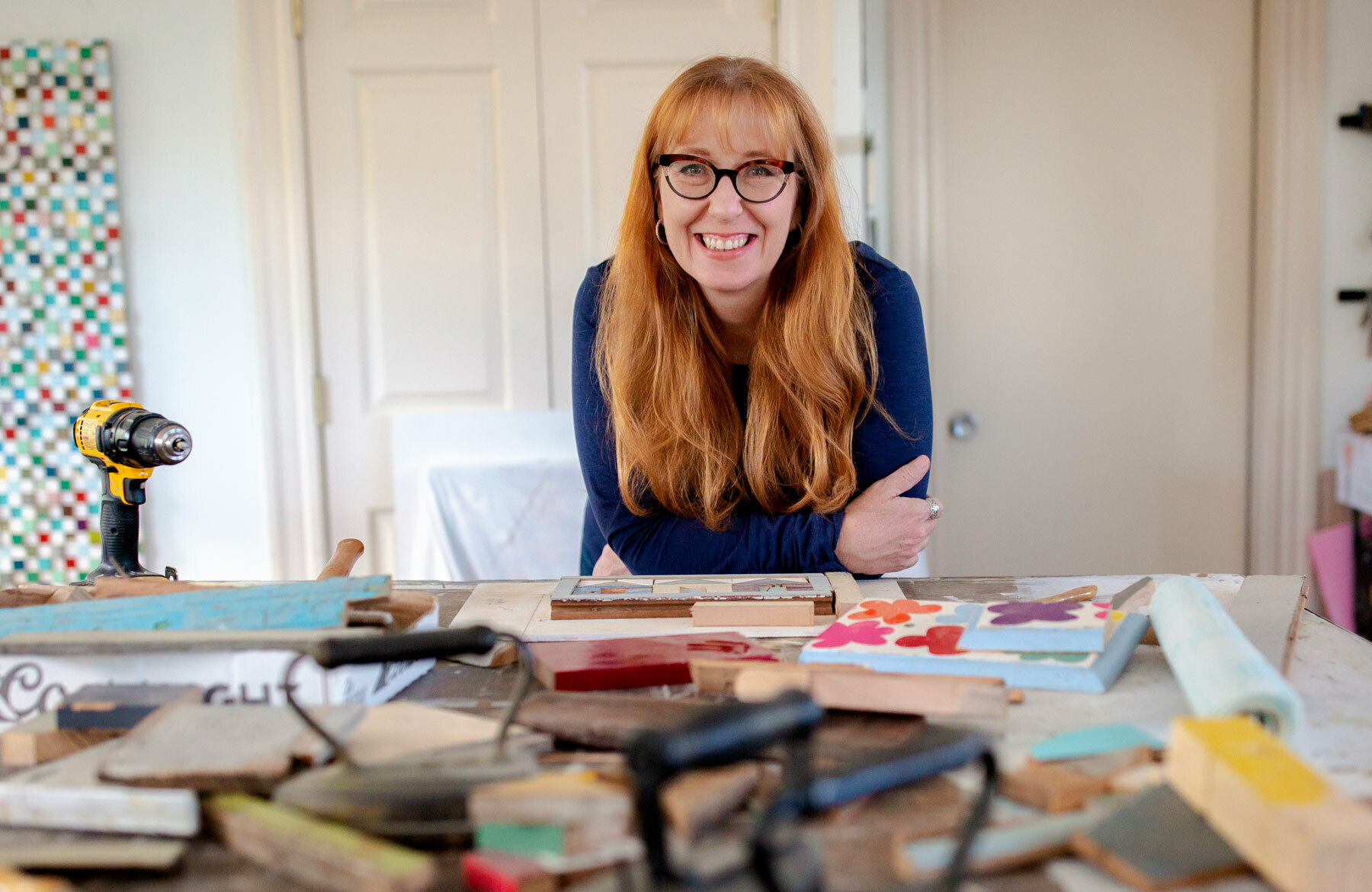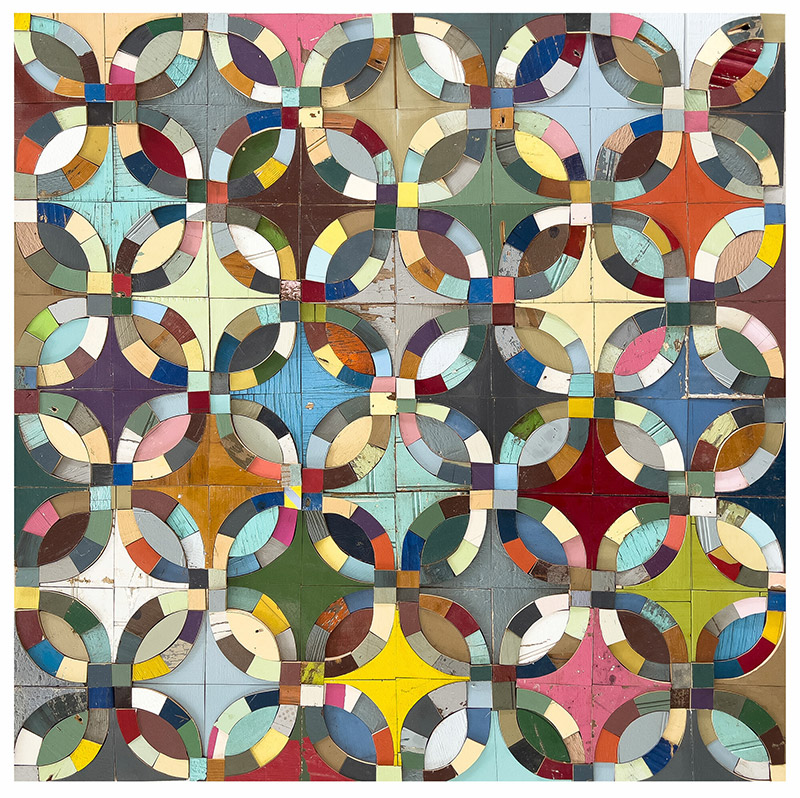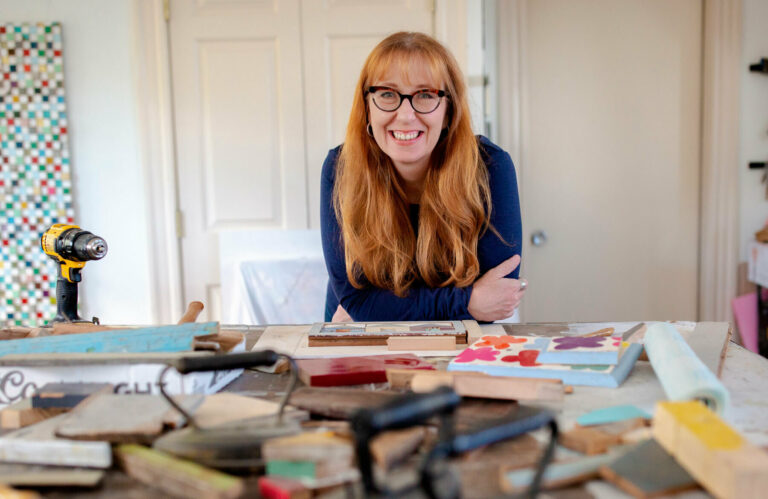
Photo courtesy of Laura Petrovich-Cheney
Laura Petrovich-Cheney, MS fashion design ’93, endured Hurricane Sandy in Asbury Park, one of the hardest-hit spots on the Jersey Shore. The town absorbed a broadside blast from the 2012 storm, that left Petrovich-Cheney without power for six weeks. Driving afterward, she saw lumber ripped from houses and furniture that had been washed out of residences like flotsam littering the streets.
“It was astounding,” she recalls. “I couldn’t get anywhere. There were not only trees on the ground; I literally ran into a dresser.”
Petrovich-Cheney couldn’t help but view the debris as a tragic symbol of planetary peril. But in a stroke of insight, she had the idea of using her art to highlight the climate crisis. She collected scraps of wood from the streets and garbage piles that became raw material for her colorful, mosaic-like works — works with an underlying message.
“The storms are getting more frequent and they’re happening in areas that don’t always see this kind of drama,” she says.
“At some point, all of us are going to be affected by a climate disaster.”
Petrovich-Cheney’s work is riddled with dualities. Her recent creations are inspired by quilts but made of wood. They hang on the wall like two-dimensional paintings but present equally as 3D sculptures, and they dissolve the fusty genre barrier between fine art and craft by being equally at home in either context. “For me, the blurring of lines is really exciting,” she says.
An avid painter from an early age, as a high schooler she one day witnessed a beautiful, yellow vintage quilt in a boutique. Petrovich-Cheney wasn’t able to purchase it, so she decided to make one for herself.
“I bought a sewing machine and got all my fabric and figured out how to sew it,” she recalls. “It was a complete disaster. I did not understand seam allowance and I didn’t pre-wash the fabric, so it shrank in an irregular way.”
But persistence is a very useful personality trait for an artist. She was just getting started.
Years later, as a graduate student in fashion design at Drexel, she vividly recalls her first task in class with the renowned designer and professor Renée Chase. “She gave us each a different pair of very complicated cargo shorts, and said she wanted us to duplicate them in a ridiculous amount of time, maybe 24 hours — but we couldn’t take them apart,” recalls Petrovich-Cheney. “Then she left the room.”
The assignment brought the class together, with students sharing expertise and talents. “It was like working together in a professional design house,” she says. “Sure enough, we got the job done. It was a fantastic experience.”

WOVEN WOOD
Some of Petrovich-Cheney’s recent works include “Devotion,” above, and “Enough Said” (2023) and “Sunshine and Shadow” (2023), on the opposite page. Her latest show runs through 2025 at the Fuller Craft Museum in Massachusetts.
Petrovich-Cheney continued her artistic studies after Drexel, earning a master’s degree in fine arts at Moore College of Art & Design in Philadelphia. The intuitive spark that motivated Petrovich-Cheney to meld painting and sculpture using quilt designs was perhaps born of a drive to integrate deep-rooted interests in her art. It has led to more than a decade of creative ferment.
To construct her work, Petrovich-Cheney often works from a drawn diagram — and custom cuts salvaged wood into geometric shapes to fill out the puzzle of her designs. “I don’t paint any of the wood. All the wood is used as I find it,” Petrovich-Cheney says. “It’s endearing to me when people say that I use so many colors, but I really don’t. A lot of times it’s the neutrality of more common grays and white wood I find that are prevalent, and it’s a question of making colors pop and sing in the abstract design,” she explains. “I employ a lot of color theory, and my color sense was strongly developed in Dennis Will’s summer design intensive at Drexel.”
Petrovich-Cheney has been especially busy of late. There was a solo show at the New England Quilt Museum last year, an appearance in the “Stitching the Revolution: Quilts as Agents of Change” exhibition at the Mattatuck Museum in Connecticut over the summer, a showing in “Women’s Work” at the A.R. Mitchell Museum of Western Art in Colorado in the fall, and from late December 2024 through September 2025, she will be showing new pieces at “Waste Not, Want Not: Craft in the Anthropocene” at the Fuller Craft Museum in Massachusetts.
Thirty years on, Petrovich-Cheney still reflects on her teachers at Drexel.
“One of the reasons why my experience at Drexel was so positive is that I did well and was encouraged to do even better,” she says. “A good teacher can make you believe that you’re capable of anything. That was so inspirational.”




